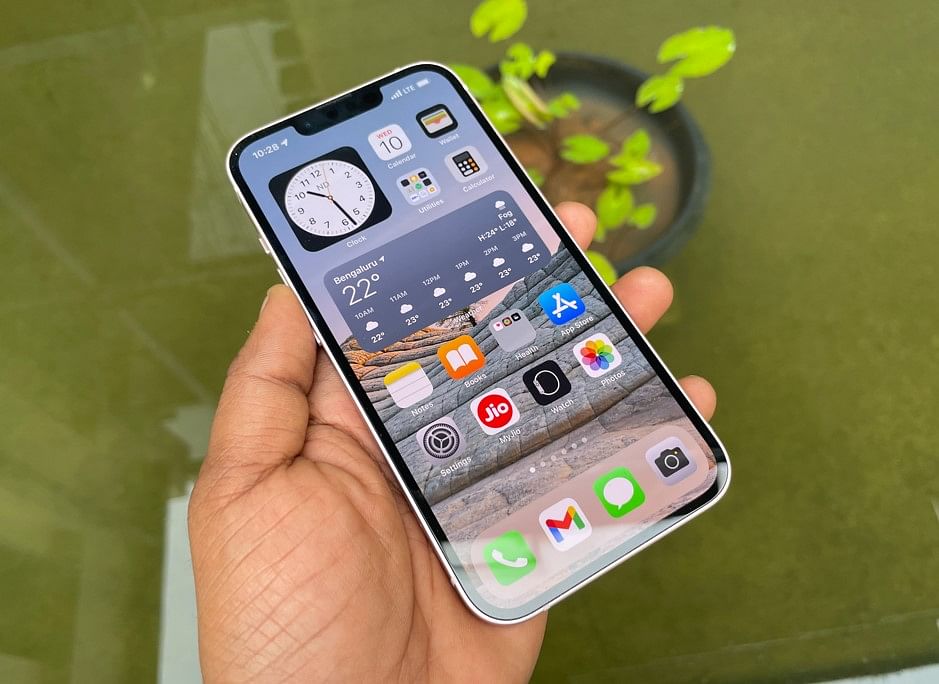

In mid-September, Apple launched four new premium handsets-- iPhone 13, 13 mini, 13 Pro and 13 Pro Max during the California Streaming event.
All the new iPhone 13 series models are now available in India with prices ranging from Rs 69,900 and Rs 1,79,900.
I tested the iPhone 13 for more than two weeks and here are my thoughts about Apple's new premium mobile.
Design, build quality and Display
The iPhone 13 retains the flat-edge design with a flushed display of the iPhone 12 series. It has the same aerospace-grade aluminium railings around the edges and a strong glass cover on the back. But, the former is a bit thicker compared to the latter. This I believe, is to increase the battery capacity. The minor change has a truly major impact (more on battery life a little later).
Also, the most noticeable visual change we notice first on the new iPhone 13 is the diagonally placed dual-cameras on the back. Apple has incorporated a couple of new and bigger sensors. The latter is the reason why they couldn't be placed vertically in the camera module like in the predecessor. But, what matters the most is the picture quality and it does a great job (scroll down to see the photo samples).
Another minor change is the notch at the top in the front display panel. Apple has reduced its size by around 20 per cent.
Our review unit is the Pink model and looks great in the sunlight with a chrome-hued Apple icon on the back. Also, the metallic chassis with matte finish blends beautifully with the rear side and also colour matched plastic antennas. The iPhone 13 is also being offered in four other colours--blue, midnight, starlight, and (PRODUCT) RED.
As far as the build quality is concerned, Apple has incorporated Ceramic Shield on the top and is touted to be the sturdiest screen guard for mobile in the industry. During the review period, I managed to keep the phone's display scratch-free.
Also, it comes with an IP68 rating and the device can sustain water pressure up to a maximum depth of 6 metres for close to 30 minutes.
Apple has covered all the bases to make them durable and survive the rigours of day-to-day activities.
But, given the high costs of the device, I still recommend the owners to get at least the phone case. Apple offers silicone-based covers in both opaque and transparent versions with MagSafe charging capability. They come with a slight protrusion on the front around the edges and this helps the iPhone survive the accidental drop with the display facing the hard surface of the floor.
I have to note that I dropped the iPhone 13 with the screen facing down. Though the blue cover case, lost a tiny spec of the silicone layer, saved the display from cracking.
Another interesting aspect of the new iPhone 13 series is that the units are being manufactured with an environment-friendly process. The antenna bands used in the iPhone 13 is made from upcycled plastic water bottles that have been chemically transformed into a stronger, high-performance material — an industry first. Also, 98 per cent of rare earth materials used in the device are fully recycled.
Furthermore, the gold, tin used for internal components and the rare earth materials used for MagSafe magnets in the back of the iPhone 13 are all 100 per cent recycled materials.
Apple has completely removed the plastic for the packaging of the device and thereby reducing a whopping 600 metric tons of plastic entering the environment.
Coming to display, the iPhone 13 features a 6.1-inch Super Retina XDR OLED (2532x1170p) screen with True Tone technology, Wide colour display (P3), Haptic Touch and 1,200 nits max brightness (HDR) and pixel density of 460 pixels per inch (ppi).
Though it lacks the ProMotion technology (up to 120Hz display refresh rate) we see in the iPhone 13 Pro series, I still had a good time watching TV series and playing games on the regular iPhone 13 with a refresh rate capped at 60Hz.
Also, I did not face any pressing issues while viewing content on the screen under direct sunlight.
Performance
Apple's iPhone 13 is powered by A15 Bionic. It is the fastest, most powerful and efficient Apple Silicon for a mobile device to date. It comes with the new 6-core CPU with two performance and four efficiency cores and a new 16-core Neural Engine.
However, it should be noted that A15 Bionic silicon in the iPhone 13 and 13 mini feature 4-core GPU, compared to 5-core GPU in the iPhone 13 Pro and 13 Pro Max. Nevertheless, I did not really see any notable difference in the gaming experience.
As advertised, the iPhone 13 worked efficiently without any signs of fatigue in terms of response time to load an app, launch and operate the camera, switch between apps, browse the internet, doomscrolling on social media platforms and other day-to-day activities.
Even while playing games too, the iPhone works smoothly. I did not face any pressing issues during the entire testing period.
Battery life
As you can see in the screenshots of the screen-time graphs, I tried my best to fully drain the iPhone 13's battery during my active hours. But, I just couldn't and had to stay awake longer. At the end of the day, it always had enough juice to last at least a couple of hours. This is a very massive improvement.
It should be noted that the iPhone 13 Pro Max is even better in terms of battery life. It can easily last two full days under normal usage.
Read more | Apple iPhone 13 Pro Max review
Photography
It features two 12MP camera sensors- Wide: ƒ/1.6 and Ultra-Wide: ƒ/2.4-- with Night mode, Deep Fusion, Sensor-shift optical image stabilisation, 2x optical zoom out, Digital zoom up to 5x, True Tone flash with Slow Sync and Smart HDR 4 for photos.
As advertised, Apple's iPhone 13 performs really good in all light conditions. Particularly, the low-light and night mode shots come off brilliantly.
As you can see the well-lit office complex photo taken in the night looks stunning. The iPhone 13 camera managed to keep the light source sharp and does not blow out much.
Also, the diya in the pot, looks so natural. The flame, the wick and the colourful contour of the diya are well captured in the dark background.
Even the ultra wide-angle pictures of the Nandi Hills looks fantastic. The colours of the clouds, the green foliage and the boulders around the hillock look really natural even when taken from a faraway distance. They don't look artificial at all.
In normal mode, the hues of the rooster with bright and shiny plumage have come good in the pictures. The photo with hairy facial and the eyes of the goats contain a lot of details. I am mighty impressed with iPhone 13's photography hardware.
The Cinematic mode is a noteworthy value-addition. The shallow depth of field and the smooth auto-focus transition from one face to another during the video recording is noteworthy. But, I still believe, it can get better in terms of edge detection around the people's heads in the scene. I am sure future software updates can fix this.
Though the iPhone 13 does not support the macro mode, it still gets pretty fine pictures of flowers with a good amount of details of the petals with natural colours in the normal mode.
Like the previous models, the iPhone 13 captures great portrait pictures. It offers six options- Natural, Studio, Contour, Stage, Stage Mono, and High‑Key Mono.
Another first for the iPhone 13 series is the Photography Styles. It offers five options-- standard, rich contrast, vibrant, warm and cool. Every style infuses its own uniqueness to the images. I love the rich contrast option, as it makes colour of the subject a bit brighter and visually appealing in the photos.
On the front, it features a 12MP TrueDepth camera. Except for the 4K ProRes video recording capability, it does everything the iPhone 13 Pro Max's front snapper does.
It is capable of recording up to 4K videos and also supports all six effects (Natural, Studio, Contour, Stage, Stage Mono, High‑Key Mono) of the Portrait lighting modes.
Yes, it does a fine job capturing selfies with natural skin tones and with portrait modes; you can capture impressive photos worthy for DPs on social media platforms.
Final thoughts
This model is a refined version of the iPhone 12. Apple has enhanced the iPhone 13 with three key upgrades -- feature-rich dual 12MP camera, efficient and powerful A15 Bionic silicon and a big battery, which matters the most for people in the premium phone segment.
The pictures captured by the new iPhone look sharp with near accurate colours. Also, Cinematic mode is a notable value-addition and makes it stand out among the rival brands in its class.
And, as mentioned earlier, I had to really push the iPhone 13 to the extreme to drain its battery. I watched more videos on social media platforms to prolong my usual screen time on the iPhone to pull the battery life percentage to under 20. This is a massive plus point for the iPhone 13.
However, I still feel iPhone 12 owners can continue using their devices. They won't miss a lot by not upgrading to a new model. If you have the cash to splurge, just go for it.
But, for people with the iPhone X, XS, XR and iPhone 11 series, the iPhone 13 is a very good upgrade.
Also, for Android phone owners, who are in two minds whether to jump the ship, this is an opportune moment to enter the famed Apple's high-walled garden-- iOS ecosystem. You can even try with the less-expensive iPhone 12 too.
It should be noted that Apple is offering the iPhone 13 base model with 128GB double that of the predecessor (starts with 64GB) for the same launch price of Rs 79,900. Also, there is 512GB storage, another first for the regular iPhone model. It costs Rs 1,09,900. There is a 256GB option for Rs 89,900.
Get the latest news on new launches, gadget reviews, apps, cybersecurity, and more on personal technology only on DH Tech.
